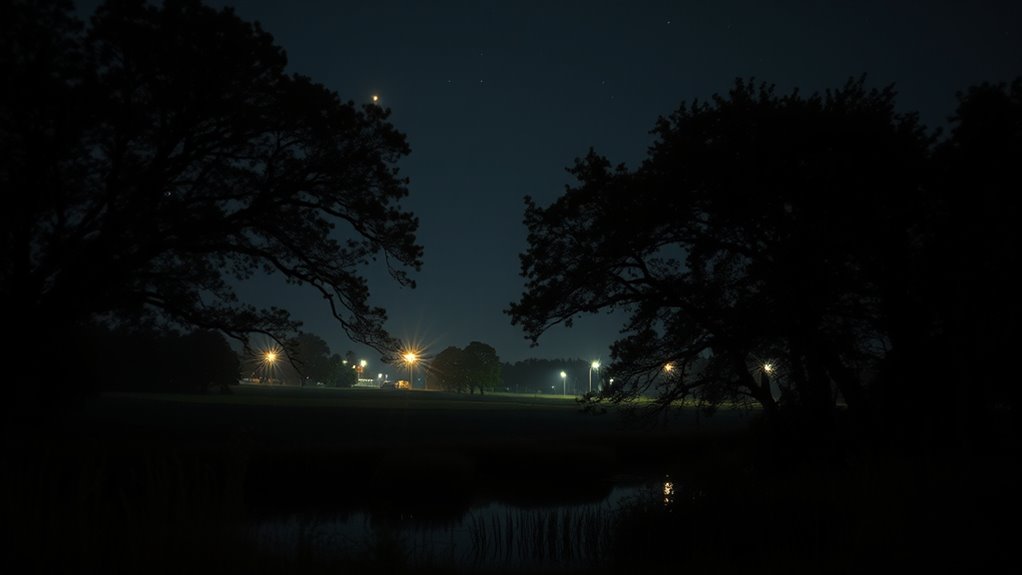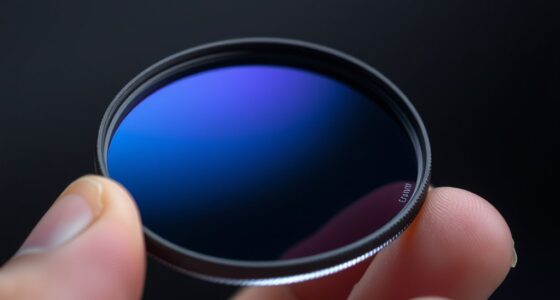Implementing light pollution reduction strategies can unexpectedly increase energy use if poorly chosen fixtures or controls aren’t used properly, and efforts in one area may just shift the glow to neighboring regions, creating new ecological or safety issues. Upfront costs for infrastructure upgrades and ongoing maintenance can also be expensive. Additionally, community outreach and enforcement often have hidden expenses, and ineffective designs might obscure safety signals. To avoid these pitfalls and maximize long-term benefits, consider the nuances discussed further.
Key Takeaways
- Implementing advanced lighting solutions without proper planning can increase energy costs and shift light pollution elsewhere.
- Large-scale retrofits and upgrades are costly, disruptive, and require ongoing maintenance, often exceeding initial budgets.
- Poorly designed lighting can cause glare and spillover, undermining safety signals and increasing accident risks.
- Insufficient community outreach and enforcement can lead to non-compliance, reducing program effectiveness and wasting resources.
- Focusing solely on local improvements may displace light pollution regionally, necessitating coordinated, multi-area strategies.
Unintended Energy Consumption
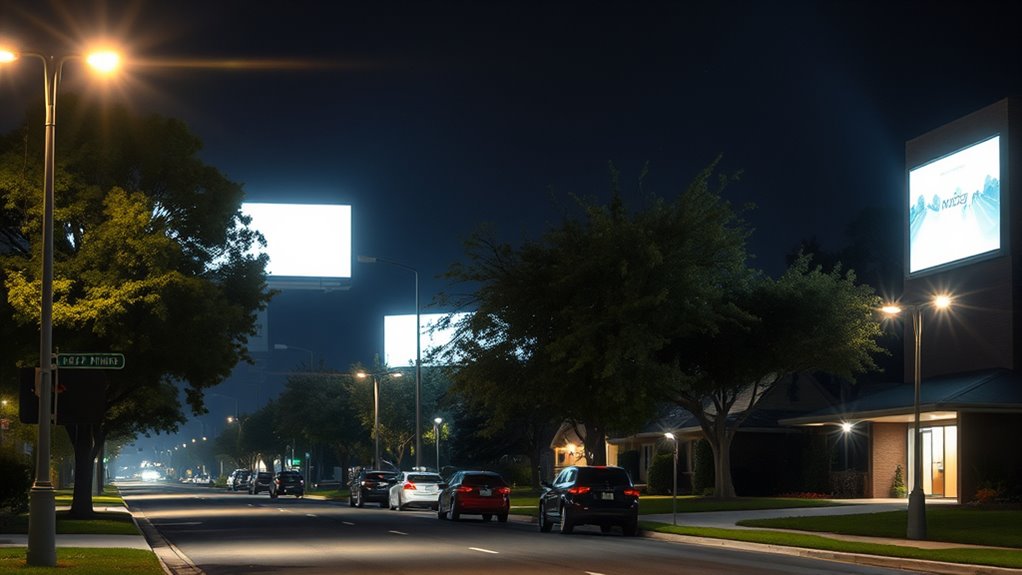
While strategies to reduce light pollution often aim to save energy, some measures can inadvertently lead to increased power use. For example, switching to poorly designed or over-illuminating fixtures might cause more energy consumption than intended. Conversely, investing in energy-efficient fixtures and smart lighting can help control light levels and reduce waste. However, if smart lighting systems are not properly programmed or maintained, they may turn on unnecessarily or use higher brightness levels, increasing power use. Additionally, installing advanced lighting solutions can sometimes encourage longer or more frequent use, negating energy savings. To avoid these pitfalls, it’s essential to select high-quality, energy-efficient fixtures and implement smart lighting controls that adapt to real needs, ensuring that efforts to reduce light pollution don’t backfire by increasing energy consumption. Proper lighting management strategies are also crucial to optimize energy use and prevent unintended consequences.
Increased Light Pollution in Other Areas
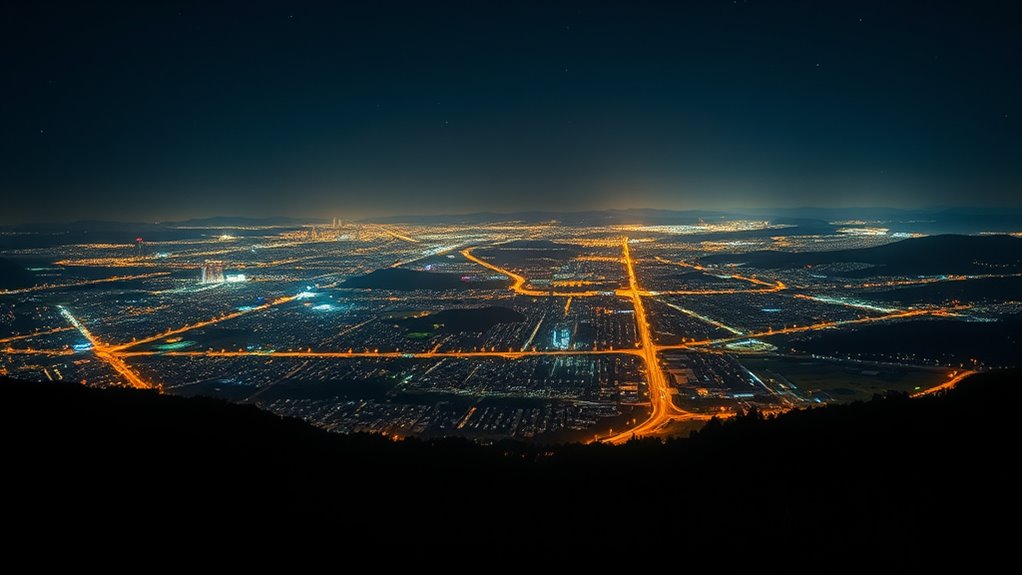
When you implement certain light pollution strategies, you might inadvertently cause spillover into dark sky areas nearby. This displacement can push the problem into new regions, affecting wildlife habitats and natural darkness. It’s important to take into account these unintended consequences before expanding your efforts. Additionally, improper outdoor lighting can contribute to increased light trespass, further disrupting ecosystems and human sleep patterns.
Spillover Into Dark Skies
Implementing certain light pollution strategies can inadvertently shift the problem elsewhere, causing increased glare and skyglow in neighboring areas. This skyglow spillover worsens the urban glow problem, making dark skies harder to preserve. When lights are improperly shielded or overly bright, brightness escapes into adjacent regions, amplifying skyglow spillover. This can lead to:
- Increased skyglow in rural or protected areas
- Disruption of natural nightscapes
- Higher glare levels for drivers and pedestrians
- Disturbance to wildlife and ecosystems
- Reduced visibility of stars in surrounding communities
These unintended consequences highlight the importance of designing lighting solutions that minimize spillover. Without careful planning, efforts to control urban glow may simply shift light pollution to nearby areas, undermining long-term dark sky preservation. Incorporating strategic lighting design can help mitigate these effects and protect natural nightscapes.
Displacement of Light Pollution
Efforts to reduce light pollution in one area can unintentionally shift the problem to neighboring regions, leading to increased light pollution elsewhere. When local authorities tighten outdoor lighting regulations, many turn to brighter or more widespread lighting to compensate, creating a stronger urban glow. This often results in heightened sky glow that spills over into nearby areas, worsening overall light pollution. Instead of solving the issue, you might push it outward, affecting communities that previously experienced less illumination. This displacement can make nearby regions appear artificially brighter and diminish the darkness needed for stargazing and natural night environments. To avoid this, you need a balanced approach that considers regional impacts and promotes targeted lighting strategies rather than simply shifting the problem elsewhere. Additionally, understanding light pollution displacement can help in designing more effective, regionally sensitive solutions that prevent unintended consequences.
Threats to Wildlife Habitats
As light pollution shifts to neighboring areas, wildlife habitats face increased disruption. This expansion impacts wildlife migration patterns, making it harder for animals to navigate safely. Habitat fragmentation worsens as artificial light divides natural landscapes, isolating populations. You might observe:
- Disrupted nocturnal behaviors in animals
- Altered migration routes causing disorientation
- Reduced breeding success due to disturbed habitats
- Increased vulnerability to predators in illuminated areas
- Loss of biodiversity as species struggle to adapt
These effects threaten the delicate balance of ecosystems, forcing wildlife to adjust or abandon crucial habitats. The spread of artificial light doesn’t just extend urban areas; it fragments ecosystems, leading to long-term ecological consequences. To protect wildlife, managing light pollution beyond city limits becomes essential.
Ecological Disruptions for Wildlife
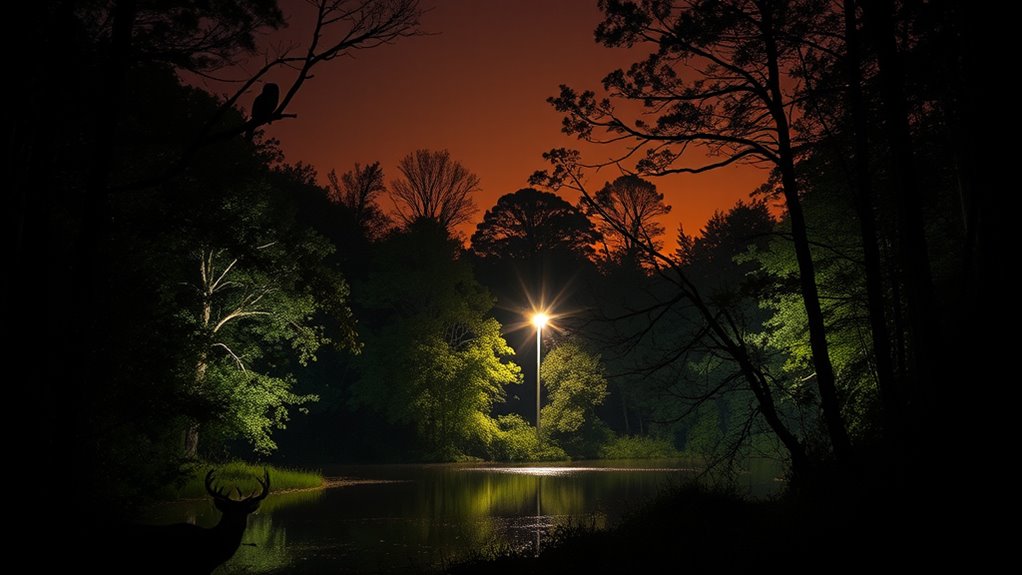
Light pollution can markedly disrupt wildlife behavior and habitats, often with unintended consequences. You might not realize that artificial light interferes with nocturnal migration, causing birds and insects to become disoriented or stray off course. This disruption can lead to increased mortality rates and decreased reproductive success. Insect populations, especially, suffer because artificial lighting attracts and traps them, reducing their numbers and impacting the animals that feed on them. These changes ripple through ecosystems, altering predator-prey relationships and weakening biodiversity. By increasing light at night, you unintentionally disturb natural rhythms and migration patterns critical for wildlife survival. Managing light pollution is essential to minimize these ecological disruptions and support healthier, more resilient ecosystems. Additionally, adopting vetted lighting strategies can help reduce these impacts without sacrificing safety or visibility.
Higher Costs for Upgrading Infrastructure
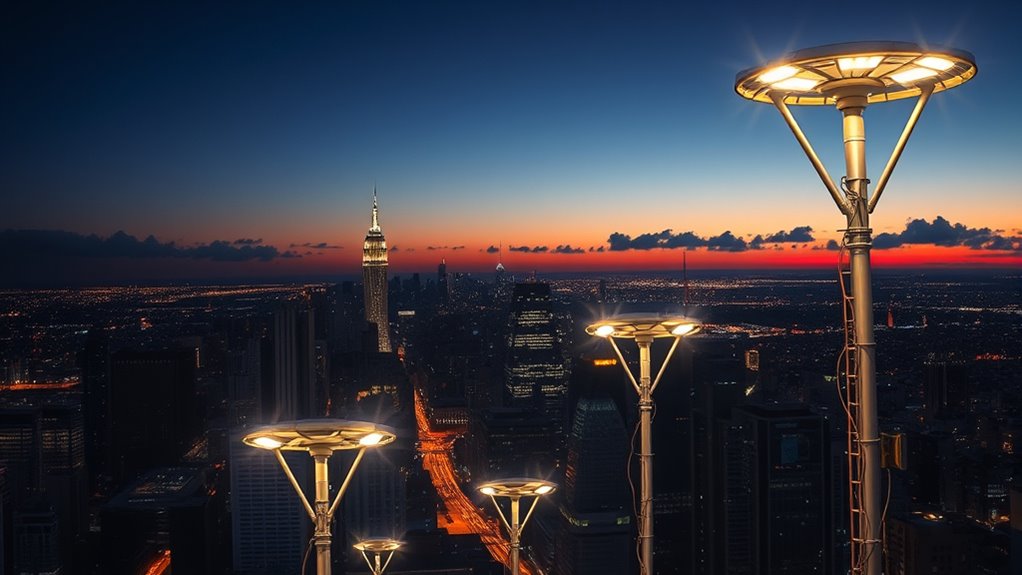
Upgrading your infrastructure to reduce light pollution often comes with steep costs. You’ll need expensive equipment overhauls and face higher ongoing maintenance expenses. Replacing outdated systems can also strain your budget more than you expect. Additionally, considering home furnishings like energy-efficient lighting options can help mitigate long-term expenses.
Expensive Equipment Overhauls
Implementing new lighting standards often requires costly equipment overhauls that can strain budgets. These upgrades involve replacing existing fixtures with costly hardware designed to reduce light pollution. The expense of these retrofits can quickly add up, especially when dealing with large areas. You might face:
- High costs of specialized fixtures
- Labor expenses for installation
- Compatibility issues with existing infrastructure
- Extended downtime during upgrades
- Ongoing training for maintenance staff
These expensive retrofits not only require significant upfront investment but also demand careful planning to avoid unforeseen costs. Balancing the need for effective light pollution mitigation with budget constraints becomes challenging when faced with these hardware upgrades. Without proper foresight, you risk overspending on equipment that may soon need replacement or further modifications. Additionally, natural materials can sometimes be more cost-effective and environmentally friendly options for sustainable lighting solutions.
Increased Maintenance Expenses
As infrastructure ages or becomes outdated, maintaining effective lighting systems can lead to substantially higher costs. Upgrading to energy efficient fixtures can reduce energy consumption, but these fixtures often require more frequent maintenance and replacement due to their complexity. Poorly designed lighting systems can also increase upkeep, as they may produce uneven illumination or cause glare, which accelerates fixture wear. Implementing strategic lighting designs helps minimize unnecessary repairs by focusing light only where needed, reducing strain on components. Additionally, emerging technologies like AI-driven solutions are being explored to optimize lighting efficiency and maintenance schedules. However, maintaining these systems still involves ongoing expenses, including routine inspections, bulb replacements, and adjustments. Over time, the combined costs of upgrading and maintaining infrastructure can surpass initial savings, making it essential to plan for long-term upkeep when considering light pollution reduction strategies.
Infrastructure Replacement Costs
Replacing outdated or ineffective lighting infrastructure often involves significant costs that can quickly add up. When you pursue lighting retrofitting or infrastructure upgrades, expect expenses beyond just new fixtures. These costs include:
- Purchasing advanced LED systems designed for better light control
- Installing new wiring and control systems to support upgraded lights
- labor costs for electricians and engineers
- potential disruptions to traffic or public spaces during upgrades
- disposal of old, potentially hazardous lighting equipment
- Additional expenses may arise from complying with lighting regulations and standards that require specialized equipment or installation procedures.
These expenses can be substantial, especially if you need to replace large sections of infrastructure or meet strict regulations. Planning for these higher costs helps you avoid surprises and ensures your investments in lighting retrofitting deliver long-term benefits without draining your budget.
Displacement of Light Pollution to Neighboring Regions
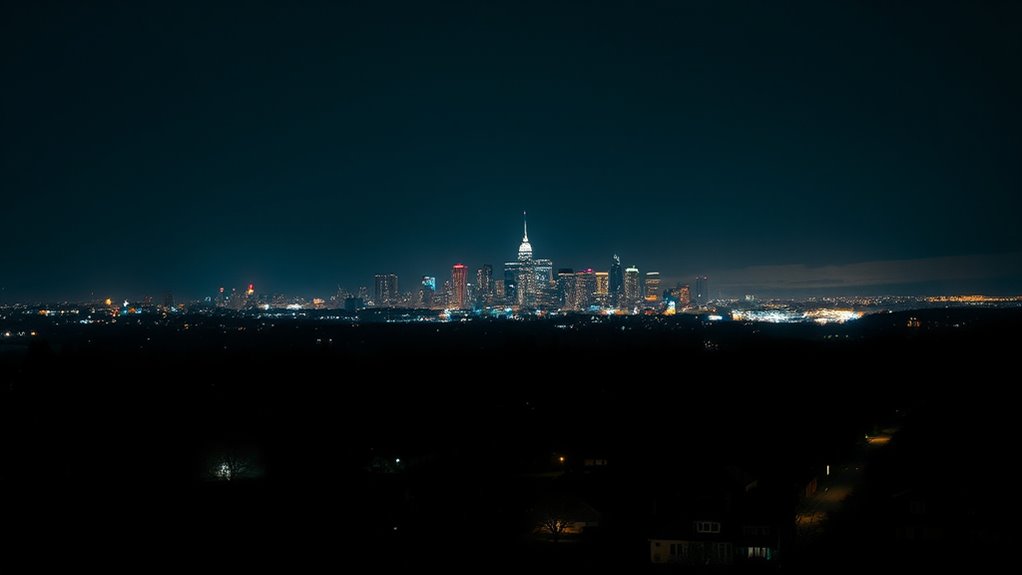
When efforts to reduce light pollution in one area are put into action, they often push the problem into neighboring regions rather than solving it entirely. This phenomenon, known as regional light shifts, involves the displacement of light pollution across borders, creating a cycle of shifting problems. Instead of eliminating excessive lighting, strategies like dimming or shielding may simply send the unwanted glow elsewhere. This neighboring region displacement can lead to increased light pollution in areas with less robust regulations or fewer resources to manage it. As a result, efforts in one zone may inadvertently worsen conditions nearby, complicating broader solutions. Addressing light pollution requires coordinated regional policies to prevent this displacement and achieve a more effective, all-encompassing reduction. Additionally, understanding the vibrational nature of energy can help in developing more holistic approaches to managing environmental impacts like light pollution.
Impact on Human Health and Well-Being
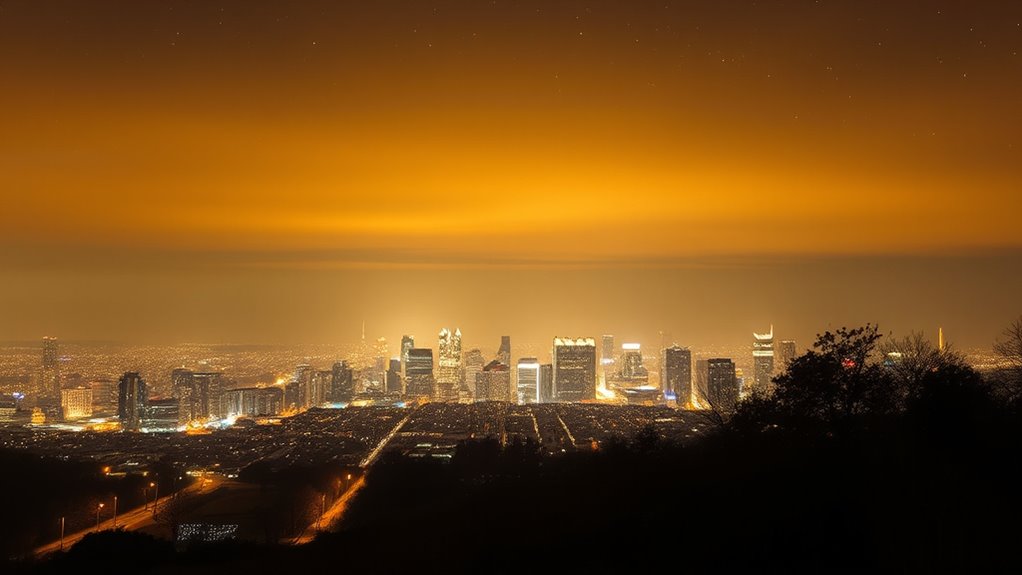
Efforts to reduce light pollution by shifting or dimming outdoor lighting can unintentionally impact your health and well-being. Excessive light pollution disrupts your circadian rhythm, leading to sleep difficulties and increased stress. Reduced exposure to natural darkness may also diminish your overall mood and cognitive function. Additionally, poorly managed lighting can cause eye strain and fatigue. Consider these potential effects:
- Disrupted sleep patterns impair recovery and alertness
- Increased risk of mood disorders like depression
- Elevated stress levels from constant light exposure
- Reduced melatonin production affecting immunity
- Impaired focus and cognitive performance
Balancing artificial lighting with natural darkness is vital to protect your human health. Misguided strategies to control light pollution might inadvertently cause more harm than good if they overlook these health impacts.
Challenges in Enforcement and Compliance
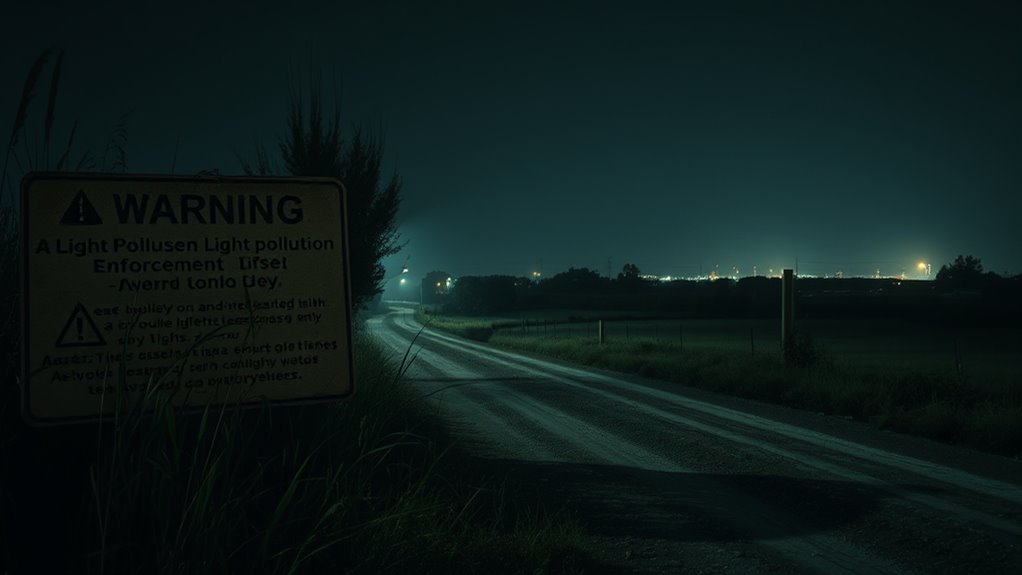
Enforcing light pollution regulations can be tough when resources are limited, making it hard to monitor compliance effectively. You might also face community engagement barriers, as some residents may resist restrictions or lack awareness. Overcoming these challenges requires strategic efforts and clear communication to guarantee rules are followed.
Enforcement Resource Limitations
Despite the importance of regulating light pollution, enforcement often faces significant resource limitations. Limited funding and personnel hinder effective compliance monitoring, making it difficult to enforce regulations consistently. Without adequate resources, authorities struggle to identify violations or conduct inspections, allowing many offenders to go unchecked. This gap reduces the overall effectiveness of light pollution strategies. To address these issues, you need to contemplate:
- Prioritizing high-risk areas for enforcement
- Training staff efficiently to maximize impact
- Leveraging technology for remote compliance monitoring
- Streamlining reporting and investigation processes
- Securing dedicated funding for enforcement activities
Community Engagement Barriers
Community engagement often poses significant challenges to enforcing light pollution regulations, as local residents and businesses may lack awareness or motivation to comply. Without strong community participation, efforts can fall flat. People might not understand how excessive lighting affects the environment or public health, leading to low compliance. To bridge this gap, fostering local awareness is essential. Here’s a quick look at common barriers:
| Barrier | Impact |
|---|---|
| Lack of information | Residents unaware of light pollution effects |
| Apathy or resistance | Little motivation to change habits |
| Perceived inconvenience | Concerns about safety or aesthetics |
| Limited outreach efforts | Insufficient community participation |
| Cultural norms | Established habits resistant to change |
Addressing these issues is key to improving enforcement and ensuring community support.
Hidden Expenses in Community Education Efforts
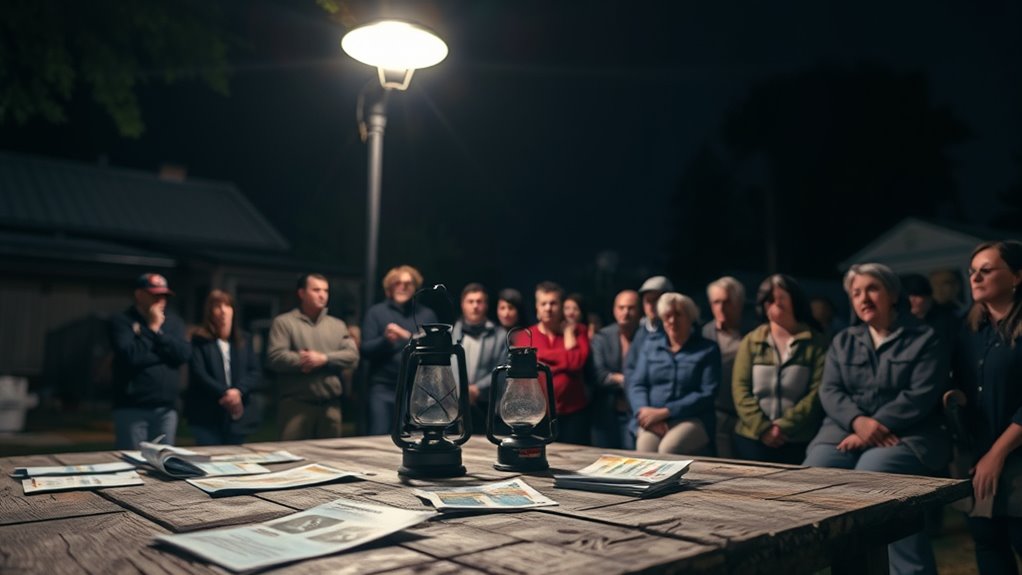
While raising awareness about light pollution might seem straightforward, it often incurs unexpected costs that can strain your resources. Implementing effective educational outreach and awareness campaigns requires more than just good intentions. You’ll need funds for materials, event logistics, and promotional efforts. Additionally, hiring knowledgeable speakers or experts can add up rapidly.
Be prepared for expenses such as:
- Printing informative brochures and signage
- Renting spaces for community events
- Advertising to reach wider audiences
- Developing digital content and social media campaigns
- Training volunteers and staff
These hidden expenses can quickly surpass your initial budget, making it essential to plan carefully and seek diverse funding sources. Proper budgeting ensures your community education efforts are impactful without causing financial strain.
Potential for Light Pollution to Obscure Safety Signals
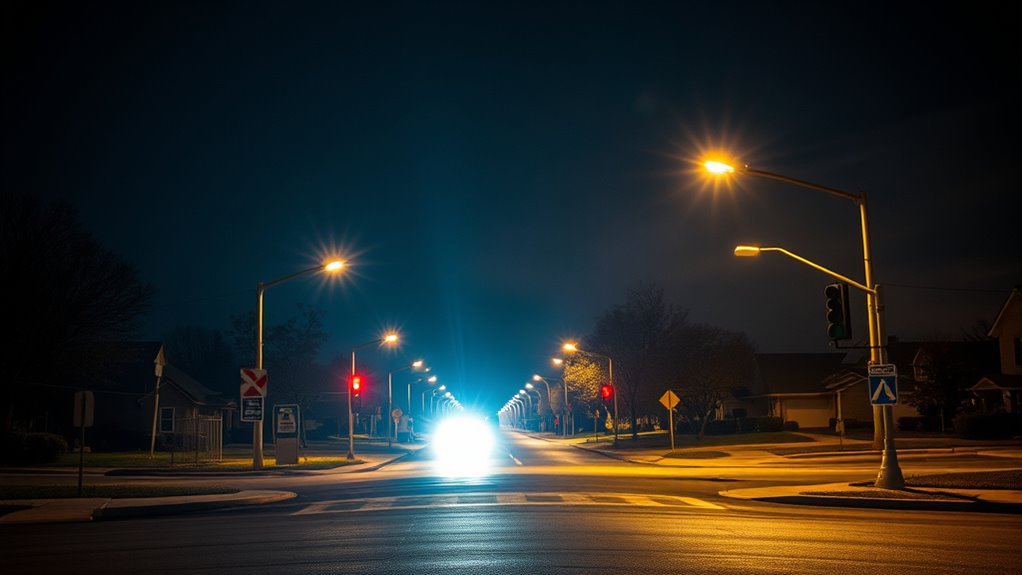
Effective educational efforts can raise awareness about light pollution, but they don’t always account for how excessive or poorly directed lighting can undermine safety signals. Glare hazards from bright, unshielded lights can impair visibility, making it harder for drivers and pedestrians to see important cues. Signal obscuration occurs when light spills into areas where safety signs, signals, or markings should be visible, reducing their effectiveness. Overly bright or misdirected lighting can create confusion rather than clarity, increasing the risk of accidents. While reducing light pollution benefits the environment, neglecting proper lighting design can inadvertently compromise safety. Balancing illumination levels with focused, shielded lighting helps ensure safety signals remain visible and effective, avoiding the unintended consequence of light pollution obscuring critical safety cues.
Balancing Costs With Long-Term Environmental Benefits
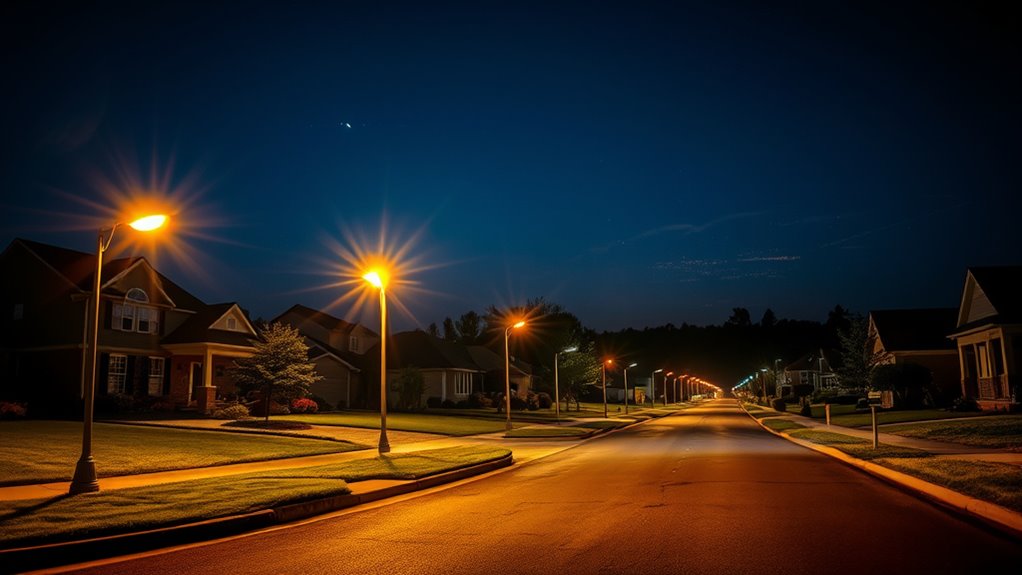
Balancing the immediate costs of implementing light pollution mitigation measures with their long-term environmental benefits requires careful consideration. Conducting a thorough cost benefit analysis helps you evaluate whether the upfront investments yield significant ecological and community gains over time. Engaging stakeholders early ensures their support and insights, making strategies more sustainable. To optimize this balance, consider:
Weigh short-term costs against long-term ecological and community benefits for sustainable lighting solutions.
- Weighing short-term expenses against future ecological improvements
- Involving local communities and policymakers for shared goals
- Prioritizing measures with high long-term impact
- Monitoring outcomes to adjust approaches effectively
- Recognizing that initial costs can prevent costly environmental damage later
Frequently Asked Questions
How Can Communities Fund Long-Term Maintenance of Light Pollution Mitigation Measures?
You can secure community funding by applying for grants, hosting fundraising events, and encouraging local businesses to sponsor maintenance costs. To manage ongoing expenses, create a dedicated budget that covers maintenance costs and establish partnerships with organizations invested in dark skies. Educate residents on the importance of preserving these measures, so they support long-term funding efforts, ensuring the sustainability of your light pollution mitigation strategies.
What Are the Hidden Costs of Replacing Outdated Lighting Fixtures?
When replacing outdated lighting fixtures, you should consider hidden costs like underestimating the total expense through accurate cost estimation, which can lead to budget shortfalls. Additionally, if you overlook fixture durability, you might face frequent replacements, increasing long-term expenses. Investing in high-quality, durable fixtures may cost more upfront but saves money over time by reducing maintenance and replacement costs. Proper planning guarantees you avoid unexpected financial burdens.
How Do Cultural Perceptions Influence the Acceptance of Light Pollution Policies?
You might find that cultural perceptions heavily influence how open people are to light pollution policies. If your community views bright lights as symbols of safety or progress, perception barriers can block acceptance. To overcome this, engage locals by highlighting environmental and health benefits, showing respect for cultural values. When people see policies as aligned with their beliefs, cultural acceptance grows, making it easier to implement effective light pollution solutions.
Are There Unforeseen Economic Impacts on Local Tourism From Lighting Restrictions?
You might face economic backlash and a tourism decline if lighting restrictions are too strict or poorly communicated. Visitors often come to enjoy vibrant night scenes or stargazing, so limiting lighting can deter them. To avoid this, you should balance environmental goals with economic interests, promote eco-friendly lighting options, and engage local businesses and tourists in planning. This way, you protect both your environment and your economy.
What Are the Potential Legal Liabilities Associated With Implementing Light Pollution Strategies?
Implementing light pollution strategies can feel like walking a legal minefield, but your biggest risks are legal compliance failures and liability risks. You could face costly lawsuits or fines if you neglect local regulations or fail to guarantee your measures meet safety standards. To avoid this, carefully review laws, document your compliance efforts, and consult legal experts. Staying proactive minimizes your exposure and keeps your initiatives on the right side of the law.
Conclusion
While implementing light pollution strategies can improve our night skies, be aware of hidden costs. For example, upgrading infrastructure might double your expenses, and unintended energy use can offset benefits. Did you know that nearly 30% of outdoor lighting waste occurs due to inefficient fixtures? By carefully planning and balancing short-term costs with long-term environmental gains, you can protect wildlife, save energy, and enjoy clearer nights without breaking the bank.
